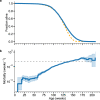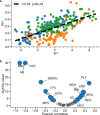Unsupervised learning of aging principles from longitudinal data
- PMID: 36319638
- PMCID: PMC9626636
- DOI: 10.1038/s41467-022-34051-9
Unsupervised learning of aging principles from longitudinal data
Abstract
Age is the leading risk factor for prevalent diseases and death. However, the relation between age-related physiological changes and lifespan is poorly understood. We combined analytical and machine learning tools to describe the aging process in large sets of longitudinal measurements. Assuming that aging results from a dynamic instability of the organism state, we designed a deep artificial neural network, including auto-encoder and auto-regression (AR) components. The AR model tied the dynamics of physiological state with the stochastic evolution of a single variable, the "dynamic frailty indicator" (dFI). In a subset of blood tests from the Mouse Phenome Database, dFI increased exponentially and predicted the remaining lifespan. The observation of the limiting dFI was consistent with the late-life mortality deceleration. dFI changed along with hallmarks of aging, including frailty index, molecular markers of inflammation, senescent cell accumulation, and responded to life-shortening (high-fat diet) and life-extending (rapamycin) treatments.
© 2022. The Author(s).
Conflict of interest statement
P.O.F is a shareholder of Gero PTE. LTD. A.V.G. is a member of Gero PTE. LTD. Advisory Board. K.A., A.E.T., L.I.M., O.B., and P.O.F. are employees of Gero PTE. LTD. A.V.G. is co-founder and shareholder of Genome Protection. E.I.A. is employee of Genome Protection. M.P.A. has no competing interests. The study was funded by Gero PTE. LTD.
Figures







References
Publication types
MeSH terms
Grants and funding
LinkOut - more resources
Full Text Sources
Research Materials

